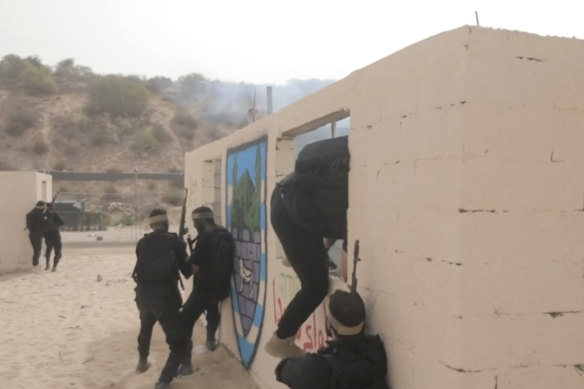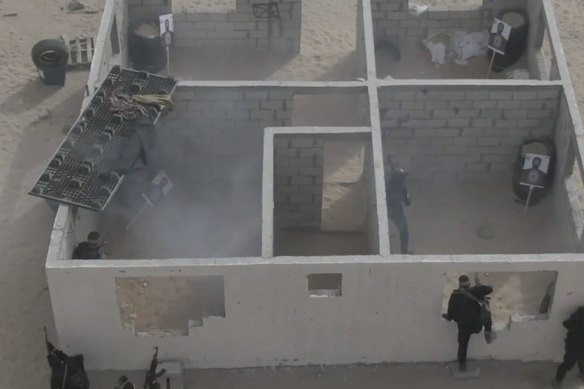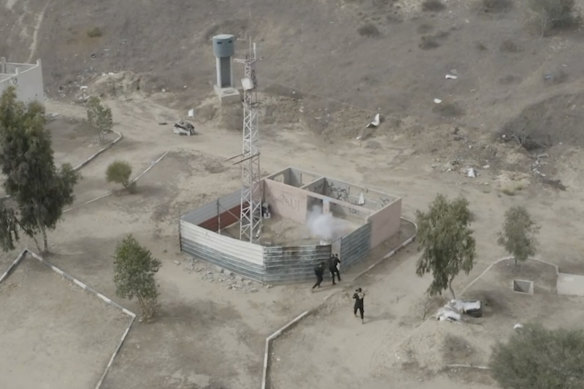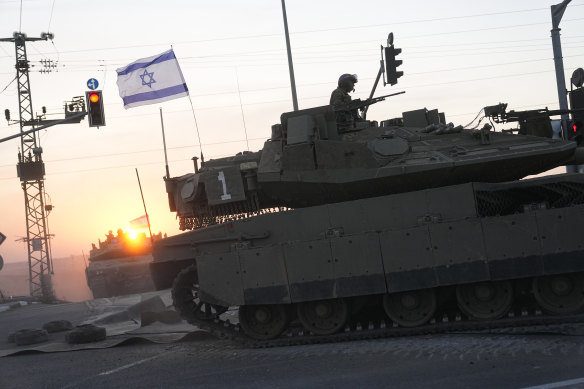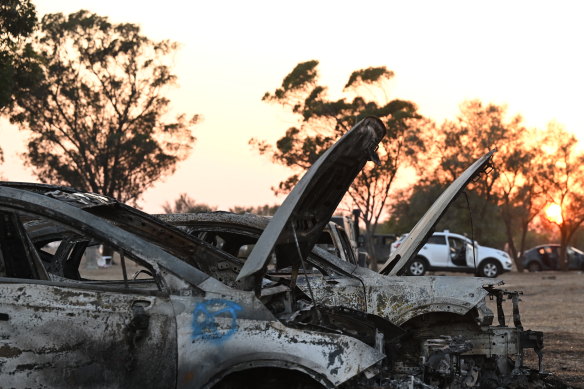Save articles for later
Add articles to your saved list and come back to them any time.
Less than a month before Hamas fighters blew through Israel’s high-tech “Iron Wall” and launched an attack that would kill more than 1300 Israelis and unleash a response that has killed 1500 Palestinians, they practised in a very public dress rehearsal.
A slickly produced two-minute propaganda video posted to social media by Hamas on September 12 shows fighters using explosives to blast through a replica of the border gate, sweep in on utes and then move building by building through a full-scale reconstruction of an Israeli town, firing automatic weapons at human-silhouetted paper targets.
This image from video posted to social media by Hamas on September 12 shows a live-fire exercise dubbed operation “Strong Pillar” outside al-Mawasi, a Palestinian town on the southern coast of the Gaza Strip.Credit: Hamas via AP
The Islamic terror group’s live-fire exercise dubbed operation “Strong Pillar” also shows militants wearing body armour and combat fatigues swiftly carrying out operations that included the destruction of mock-ups of the wall’s concrete towers and a communications antenna, just as they would do for real in the deadly attack last Saturday.
While Israel’s highly regarded security and intelligence services were clearly caught flatfooted by Hamas’ ability to breach its Gaza defences, the group appears to have hidden its extensive preparations for the deadly assault in plain sight.
“There clearly were warnings and indications that should have been picked up,” said Bradley Bowman, a former US Army officer who is now senior director of the Centre on Military and Political Power at the Foundation for defence of Democracies, a Washington research institute. “Or maybe they were picked up, but they didn’t spark necessary preparations to prevent these horrific terrorist acts from happening.”
The Associated Press reviewed and verified key details from dozens of videos Hamas released over the last year, primarily on the social media app Telegram.
Hamas conducted an annual live-fire exercise some four months earlier than usual, in a mock Israeli town. The propaganda video of the drills has been interpreted as a drill for last week’s attack.Credit: Hamas via AP
Using satellite imagery, the AP matched the location of the mocked-up town to a patch of desert outside al-Mawasi, a Palestinian town on the southern coast of the Gaza Strip. A large sign in Hebrew and Arabic at the gate says Horesh Yaron, the name of a controversial Israeli settlement in the occupied Palestinian West Bank.
Bowman said there were indications that Hamas intentionally led Israeli officials to believe it was preparing to carry out raids in the West Bank, rather than Gaza. It was also potentially significant that the exercise has been held annually since 2020 in December, but was moved up by nearly four months this year to coincide with the anniversary of Israel’s 2005 withdrawal from Gaza.
In a separate video posted to Telegram from last year’s Strong Pillar exercise on December 28, Hamas fighters are shown storming what appears to be a mock-up Israeli military base, complete with a full-size model of a tank with an Israeli flag flying from its turret. The gunmen move through the cinder block buildings, seizing other men playing the roles of Israeli soldiers as hostages.
Michael Milshtein, a retired Israeli colonel who previously led the military intelligence department overseeing the Palestinian territories, said he was aware of the Hamas videos, but he was still caught off guard by the ambition and scale of last weekend’s attack.
“We knew about the drones, we knew about booby traps, we knew about cyberattacks and the marine forces … The surprise was the coordination between all those systems,” Milshtein said.
Nearly a month before its massive surprise attack, Hamas published propaganda videos showing a practice drill that even involved blowing up communications towers, as happened on Saturday.Credit: Hamas/AP
The seeds of Israel’s failure to anticipate and stop the attack go back at least a decade. Faced with recurring attacks from Hamas militants tunnelling under Israel’s border fence, Prime Minister Benjamin Netanyahu proposed a very concrete solution: build a bigger wall.
With financial help from US taxpayers, Israel completed construction of a $US1.1 billion ($1.7 billion) project to fortify its existing defences along its 51-kilometre land border with Gaza in 2021. The new, upgraded barrier includes a “smart fence” up to six metres high, festooned with cameras that can see in the dark, razor wire and seismic sensors capable of detecting the digging of tunnels more than 60 metres below. Manned guard posts were replaced with concrete towers topped with remote-controlled machine guns.
“In our neighbourhood, we need to protect ourselves from wild beasts,” Netanyahu said in 2016, referring to Palestinians and neighbouring Arab states. “At the end of the day as I see it, there will be a fence like this one surrounding Israel in its entirety.”
Israeli tanks head towards the Gaza Strip border in southern Israel on Thursday. last weekend’s attack by Hamas prompted a declaration of war by Israeli Prime Minister Benjamin Netanyahu.Credit: AP
Shortly after dawn on Saturday, Hamas fighters pushed through Netanyahu’s wall in a matter of minutes. And they did it on the relative cheap, using explosive charges to blow holes in the barrier and then sending in bulldozers to widen the breaches as fighters streamed through on motorcycles and in utes. Cameras and communications gear were bombarded by off-the-shelf commercial drones adapted to drop hand grenades and mortar shells – a tactic borrowed directly from the battlefields of Ukraine.
Snipers took out Israel’s sophisticated roboguns by targeting their exposed ammunition boxes, causing them to explode. Militants armed with assault rifles sailed over the Israeli defences slung under paragliders, providing Hamas airborne troops despite lacking airplanes. Increasingly sophisticated homemade rockets, capable of striking Israel’s capital of Tel Aviv, substituted for a lack of heavy artillery.
Satellite images analysed by the AP show the massive extent of the damage done at the heavily fortified Erez border crossing between Gaza and Israel. The images taken on Sunday and analysed on Tuesday showed gaping holes in three sections of the border wall, the largest more than 70 metres wide.
Burnt out cars the site of the Supernova Music Festival in Kibbutz Re’im when Israelis were massacred on Saturday. Israeli soldiers continue to search for ID and belongings among the cars and tents.Credit: Getty
Once the wall was breached, Hamas fighters streamed through by the hundreds. A video showed a lone Israeli battle tank rushing to the sight of the attack, only to be attacked and quickly destroyed in a ball of flame. Hamas then disabled radio towers and radar sites, likely impeding the ability of the Israeli commanders to see and understand the extent of the attack.
Hamas forces also struck a nearby army base near Zikim, engaging in an intense firefight with Israeli troops before overrunning the post. Videos posted by Hamas show graphic scenes with dozens of dead Israeli soldiers.
They then fanned out across the countryside of southern Israel, attacking kibbutzim and a music festival. On the bodies of some of the Hamas militants killed during the invasion were detailed maps showing planned zones and routes of attack, according to images posted by Israeli first responders who recovered some of the corpses. Israeli authorities announced on Wednesday they had recovered the bodies of about 1500 Islamic fighters, though no details were provided about where they were found or how they died.
Military experts said the attack showed a level of sophistication not previously exhibited by Hamas, likely suggesting they had external help.
“I just was impressed with Hamas’s ability to use basics and fundamentals to be able to penetrate the wall,” said retired US Army Lieutenant Colonel Stephen Danner, a combat engineer trained to build and breach defences. “They seemed to be able to find those weak spots and penetrate quickly and then exploit that breach.”
Ali Barakeh, a Beirut-based senior Hamas official, acknowledged that over the years the group had received supplies, financial support, military expertise and training from its allies abroad, including Iran and Hezbollah in Lebanon. But he insisted the recent operation to breach Israel’s border defences was homegrown, with the exact date and time for the attack known only to a handful of commanders within Hamas.
Details of the operation were kept so tight that some Hamas fighters who took part in the assault believed they were heading to just another drill, showing up in street clothes rather than their uniforms, Barakeh said.
Last weekend’s devastating surprise attack has shaken political support for Netanyahu within Israel, who pushed ahead with spending big to build walls despite some within his own cabinet and military warning that it probably wouldn’t work.
In the days since Hamas struck, senior Israeli officials have largely deflected questions about the wall and the apparent intelligence failure. Rear Admiral Daniel Hagari, the chief spokesman for the Israel defence Forces, acknowledged the military owes the public an explanation, but said now is not the time.
“First, we fight, then we investigate,” he said.
In his push to build border walls, Netanyahu found an enthusiastic partner in then-president Donald Trump, who praised Netanyahu’s Iron Wall as a potential model for the expanded barrier he planned for the US Southern border with Mexico.
Under Trump, the US expanded a joint initiative with Israel started under the Obama administration to develop technologies for detecting underground tunnels along the Gaza border defences. Since 2016, Congress has appropriated $US320 million ($506 million) towards the project.
But even with all its high-tech gadgets, the Iron Wall was still largely just a physical barrier that could be breached, said Victor Tricaud, a senior analyst with the London-based consulting firm Control Risks.
“The fence, no matter how many sensors … no matter how deep the underground obstacles go, at the end of the day, it’s effectively a metal fence,” he said. “Explosives, bulldozers can eventually get through it. What was remarkable was Hamas’s capability to keep all the preparations under wraps.”
AP
More coverage of the Israeli-Palestinian conflict
- Surprise attack: Hamas terrorists fired up to 5000 rockets from Gaza into Israel on October 7, triggering a declaration of war. Read our guide to the militant group and why it’s at war with Israel.
- The Iron Dome explained: How did Hamas breach Israel’s sophisticated anti-ballistic missile system? And why didn’t Israel’s intelligence services see these attacks coming?
- Tragedy in Israel: A 66-year-old Sydney woman has been killed and is the first known Australian casualty. Foreign Affairs Minister Penny Wong says the woman’s family in Israel and Australia is receiving consular assistance.
- What’s next: International editor Peter Hartcher joins the Please Explain podcast to analyse the escalating conflict in the Gaza Strip – and explain why a much bigger conflict is afoot.
Most Viewed in World
From our partners
Source: Read Full Article
